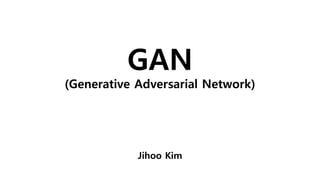
GAN - Generative Adversarial Nets
- 2. 2004~2009, Stanford University (B.S. M.S. in Computer Science) 2010~2014, Université de Montréal (Ph.D. in Machine Learning ) 2015~2016, Google Brain (Research Scientist) 2016~2017, OpenAI Institute 2017~2019, Google Brain (Research Scientist) 2019.03~ Apple Inc. (Director of Machine Learning) Advances in Neural Information Processing Systems 27 (NIPS 2014) Generative Adversarial Nets (Ian Goodfellow) Ian Goodfellow 1985년생 GAN 저자
- 3. GAN 개념 <Unsupervised Learning의 대표 주자 GAN> 단순히 Supervised Learning에 의해 분류만 하는 것이 아니라, 정답 없이 새로운 것을 지속적으로 생성해낼 수 있는 능력을 가진다는 것 은 그 데이터를 완전히 이해하고 있다는 의미로서, 생성하는 능력을 가지게 되면 분류하는 것도 자동적으로 쉽게 할 수 있음 (= 어려운 수학 문제를 다른 사람에게 설명을 잘 할 수 있다면, 그 문제를 푸는 일은 식은 죽 먹기) “What I cannot create, I do not understand” - 노벨 물리학상을 받은 미국의 물리학자 Richard Feynman
- 4. GAN 개념 <GAN을 경찰과 위조지폐범에 비유> 처음 GAN을 제안한 Ian Goodfellow는 GAN을 경찰과 위조지폐범 사이의 게임에 비유함 위조지폐범은 최대한 진짜 같은 화폐를 만들어(생성) 경찰을 속이기 위해 노력함 경찰은 진짜 화폐와 가짜 화폐를 완벽히 판별(분류)하여 위조지폐범을 검거하는 것을 목표로 함 이러한 경쟁적인 학습이 지속되면 위조지폐범은 점점 더 진짜같은 위조지폐를 만들 수 있게 되고, 어느 순간 경찰이 위조지폐를 구별할 확률이 50%로 수렴하여 실제와 구분할 수 없게 됨
- 5. <분류모델의 학습> 1단계: 진짜 데이터를 입력해서 네트워크가 해당 데이터를 진짜로 분류하도록 학습시키는 과정 2단계: 생성 모델에서 생성한 가짜 데이터를 입력해서 해당 데이터를 가짜로 분류하도록 학습시키는 과정 <생성모델의 학습> 분류모델을 학습시킨 다음에 학습된 분류모델을 속이는 방향으로 생성모델을 학습시켜줘야 함 이와 같은 학습과정을 반복하면, 생성모델을 분류에 성공할 확률을 낮추려 하고, 분류모델은 분류에 성공할 확률을 높이려 하면서 서로가 서로를 경쟁적으로 발전시키는 구조 GAN 학습
- 6. GAN 학습 보다 구체적으로, GAN은 아래와 같은 목적함수 V(D,G)를 이용하여, 아래 수식처럼 minimax problem을 푸는 방식으로 학습 D: Discriminator G: Generator V(D,G): Value Function 실제 데이터에 대한 확률분포에서 샘플링한 데이터 x (= Sample x from Real Data Distribution) 가우시안분포를 사용하는 임의의 노이즈에서 샘플링한 데이터 z (= Sample z from Gaussian Distribution) D(x): Discriminator가 x를 real data라고 판별할 확률 (0~1 사이의 값) x가 real data라고 판별하면, D(x)=1 x가 fake data라고 판별하면, D(x)=0 D(G(z)): Generator가 만든 fake data G(z)를 real data라고 판별할 확률 (0~1 사이의 값) G(z)가 real data라고 판별하면, D(G(z))=1 G(z)가 fake data라고 판별하면, D(G(z))=0
- 7. 최대가 되어야 함 D(x) = 1이 되어야 함 진짜 데이터를 진짜로 분류하도록 학습 (1단계) 최대가 되어야 함 1-D(G(z)) = 1이 되어야 함, D(G(z)) = 0 가짜 데이터를 가짜로 분류하도록 학습 (2단계) <분류모델(D)의 학습> 1단계: 진짜 데이터를 입력해서 네트워크가 해당 데이터를 진짜로 분류하도록 학습시키는 과정 2단계: 생성 모델에서 생성한 가짜 데이터를 입력해서 해당 데이터를 가짜로 분류하도록 학습시키는 과정 GAN 학습 Discriminator 관점 log(x)
- 8. <생성모델(G)의 학습> 분류모델을 학습시킨 다음에 학습된 분류모델을 속이는 방향으로 생성모델을 학습시켜줘야 함 최소가 되어야 함 1-D(G(z)) = 0이 되어야 함, D(G(z)) = 1 분류모델(D)을 속이는 방향으로 학습 Generator 관점 GAN 학습
- 9. GAN 학습 Data Generating Distribution(pdata) (= Real Data) Generative Distribution(pg) (= Fake Data) Discriminative Distribution(D) x=G(z) mapping을 통해 만들어진 가짜 데이터 분포(pg) D*(x)= 을 통해 판별 확률 분포(D) 업데이트 가짜 데이터 분포(pg)를 진짜 데이터 분포(pdata)에 가깝도록 업데이트 학습을 계속 반복하면, 가짜(pg)= 진짜(pdata) 두 분포를 구분할 수 없을 정도로 되어 D(x) = 1/2 D(x) = 1/2
- 10. <GAN이 잘 작동하는 이유> 실제로 진짜 데이터 분포(pdata)와 가짜 데이터 분포(pg), 두 분포 사이의 거리를 줄이는 방향으로 학습하기 때문 GAN 원리
- 11. KL(p ||q) = • 두 분포가 얼마나 비슷하게 생겼는지를 알기 위한 척도 • 원본 데이터가 가지고 있는 정보량을 잘 보존할 수록 원본 데이터와 비슷한 분포 • 원본 확률 분포 p와 근사된 분포 q에 대하여 i번째 item이 가진 정보량의 차이(정보 손실량)의 기댓값 • KL-Divergence는 Symmetric하지 않음, KL(p ||q) ≠ KL(q ||p) • 두 확률 분포 사이의 distance로서의 역할을 하기 위해 KL-Divergence를 Symmetric하도록 개량, JSD(p ||q) = JSD(q ||p) Kullback-Leibler(KL) Divergence Jensen-Shannon(JS) Divergence GAN 원리
- 12. GAN 증명
- 13. GAN 증명
- 14. GAN 증명
- 15. GAN 증명
- 16. GAN 증명
- 17. GAN 증명
- 18. GAN 증명
- 19. GAN 증명
- 20. GAN 증명
- 21. GAN 증명
- 22. GAN 증명
- 23. GAN 증명
- 24. GAN 증명